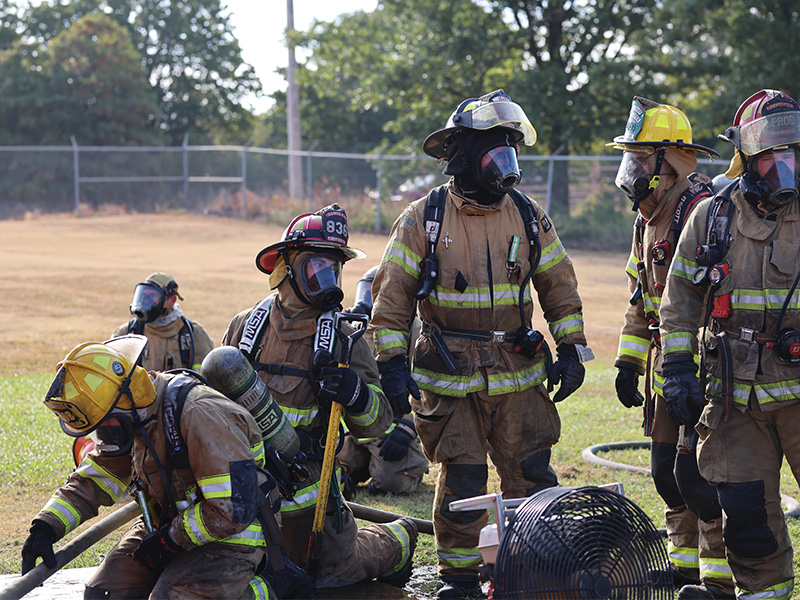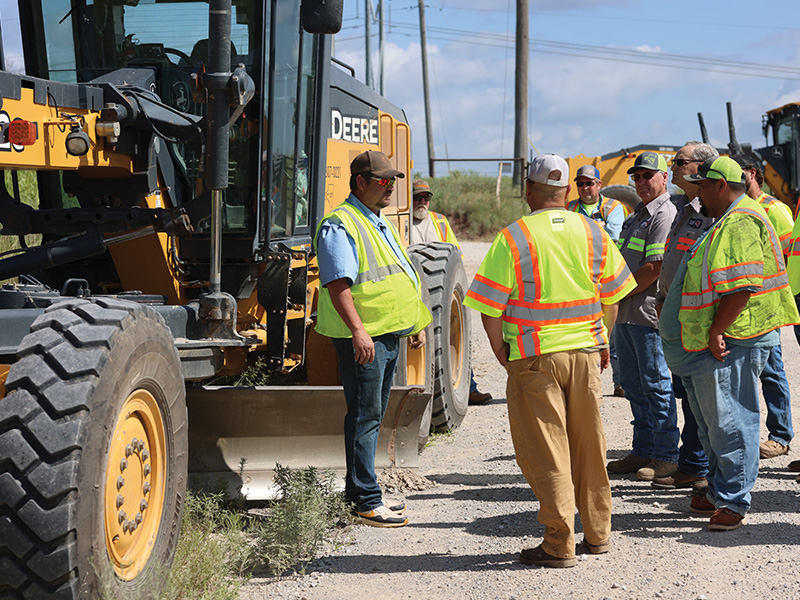
Statewide Solutions: CEAT Extension aids all 77 counties from road safety to fire protection
Thursday, October 2, 2025
Media Contact: Kristi Wheeler | Marketing and Communications Manager | 405-744-5831 | kristi.wheeler@okstate.edu
The College of Engineering, Architecture and Technology is a beacon of engineering innovation.
It also shines a light on Engineering Extension, enhancing the careers of those who make up Oklahoma’s workforce.
Through extension and outreach efforts, CEAT provides training and expertise that impacts all 77 counties in Oklahoma. This benefits the state, holding true to Oklahoma State University’s land-grant mission.
CEAT extension impacts the professional preparedness of first responders as well as training for those who upkeep the state’s infrastructure. It also gives students valuable experience for future careers.
Road Map
For nearly 100 years, CEAT Professional Development has provided practical, applied training across many industries, including defense, construction, health and safety.
CEAT PD recently launched the Center for Transportation and Construction Workforce to enhance its partnerships and ability to expand continuing education and training.
This initiative unites multiple programs: the Local Technical Assistance Program, the Tribal Technical Assistance Program, the Highway Construction Materials Technician program and the Oklahoma Pilot Escort Certification Program.
Since the 1980s, LTAP has provided training and technical assistance to government organizations that plan, maintain and build transportation systems locally.

TTAP enhances the quality of life in tribal communities by providing training and building capacity for tribes to administer and manage their individual transportation programs.
HCMT certifies technicians responsible for sampling and testing materials used in highway construction projects.
The pilot escort program, the only one in the state, provides certification training for operating pilot vehicles, which accompany oversized loads during transport to ensure safety. This program sees attendees from multiple states.
The center consolidates these programs to streamline workforce development.
“We wondered why these programs were operating individually when we could streamline them and put them under a center to create better pathways for their careers and workforce development,” said Jessica Stewart, director of CEAT PD.
Stewart said the center actively gathers feedback from stakeholders to identify and meet the most pressing training needs. More than 2,000 people were enrolled in these programs last year, many of whom came from rural areas.
"Not only does the center make us stronger in terms of serving Oklahoma’s workforce in general by working as a unit to help workforce development, there’s also a more uniform basis for it all."
“Being able to do that with classes that are locally available and affordable, including some that are free, has a huge impact on the communities that these people are serving,” Stewart said. “And it’s also important for our infrastructure, too, as a state.”
Dr. Dan Cook, assistant professor of construction engineering technology, is also the assistant director of the CTCW and director of the HCMT program. He said many opportunities available to students through the centers can impact their future careers.
Undergraduates and graduates can work as teaching or research assistants. Students may work part-time with organizations like the Oklahoma Department of Transportation.
“Not only does the center make us stronger in terms of serving Oklahoma’s workforce in general by working as a unit to help workforce development, there’s also a more uniform basis for it all,” Cook said. “And with the cross net of instructors and evaluators, it just makes all those programs so much stronger.”
The biggest impact the CTCW makes is its ability to empower communities. People can further their careers and impact their community and state.
“One thing that’s been really important for us in creating this center is to generate excitement and interest in extension training programs and then make it a simpler process for extension or for faculty members to work in these extension courses and teach with us,” Stewart said.
Teaching the world
Our college has gained a worldwide reputation for its high-quality training materials that enhance fire department operations around the globe.
CEAT’s Fire Protection Publications is the world’s leading publisher of fire-related education and training materials, known for content validated by the International Fire Service Training Association.
One such publication is the International Fire Service Journal for Leadership and Management. For nearly 20 years, the IFSJLM has advanced the international fire service by publishing peer-reviewed articles that enhance fire leadership and management theory and practice. FPP funds the journal as well as the annual research symposium for IFSJLM.
The journal influences global fire service training curriculum. By equipping them with the best training materials possible, it helps make communities better by saving lives and property.

The articles are geared toward an international audience of academics and in-service fire and emergency management professionals to enhance fire leadership and management theory and practice.
Bob England, professor emeritus with CEAT and the journal’s founding editor, was asked 20 years ago to create the journal as a tool for the international fire service by Chris Neal, then director of FPP.
FPP initially published the journal as a service to the international fire community and later created the annual research symposium to support the journal.
“I would ask nationally and internationally recognized fire service leaders and research scholars to speak on the Saturday before the opening session of the summer IFSTA Validation Conference,” England said. “The symposium was created as a value-added experience to reward the important work performed by the members of IFSTA validation committees.”
It took about two years to get the first journal printed in 2007, and for the first four years, two issues were published annually before moving to one publication per year in 2011. The journal to be published this fall will be Volume 19.
All articles, unless otherwise noted, are peer-reviewed by fire service professionals. This ensures that the content is accurate, relevant and grounded in theory, that the methods applied are used appropriately, and that the article advances the understanding of fire and leadership management.
England said the journal has significantly impacted the professional development of leaders in the fire service over the past two decades.
England said it is the editorial team’s responsibility and honor to help practitioner-scholars succeed.
“Some of the leading scholars, both in the United States and internationally, who write fire-related articles have been published in the IFSJLM,” England said. “In addition, during the past 20 years, the IFSJLM editorial team has taken great effort to work with and mentor emerging early career scholars.”
Advancing careers
For 15 years, the Oklahoma Executive Fire Officer Leadership Program has helped fire service leaders advance their careers.
It is a partnership between OSU Fire Service Training, the Oklahoma Fire Chiefs Association, the Oklahoma State Firefighters Association and the Office of the State Fire Marshal.
Some of the topics covered include developing a personal philosophy of leadership and ethics, leading others ethically, ethical leadership in organizations, ethics and the challenge of leadership.
Rodney Foster, a program instructor, has seen incredible growth and development in the leadership abilities of the officers who have gone through the program, which has benefited the cities and communities they serve.
“The impact the program has had is immeasurable,” Foster said. “For us to understand the influence we have had on departments throughout the state would be very difficult.”
It includes 160 hours of training across four 40-hour courses. Its coursework is like that of the International Public Safety Leadership and Ethics Institute, which focuses on ethics and leadership in a public role. The course brings together veteran officers with younger officers in learning environments.
"The impact the program has had is immeasurable. For us to understand the influence we have had on departments throughout the state would be very difficult.”
Foster said the course has been made a requirement by some cities to become an officer in a fire department.
“One of the unique things about training in the fire service is that most promotions are based upon rank and/or training,” Foster said. “The program has been placed into a few municipalities’ contracts, which are making it a requirement to promote. Departments that don’t have this in their contract are still gaining knowledgeable personnel to promote in the future. I believe the personnel who have had a chance to attend are elevating leadership qualities.”
The coursework provides leadership development for multiple positions in a fire department, including battalion chiefs, deputy chiefs, captains and lieutenants. About 5% of the chiefs in the state’s 800 departments have completed the training, and the ability to have people in other leadership roles also take part impacts an entire department.
Most of the state’s fire departments are made up of volunteers, and there is a goal to have a course option for volunteer departments by the summer of 2026.
Foster said the books and journals completed during the program allow officers to strengthen their leadership skills.
“Each person has different leadership styles, and we hope this program enhances the leadership qualities that each person brings to the position,” Foster said.
Foster, who completed the program three years ago, feels fortunate to be a part of such an important program and looks forward to supporting the program’s continuing success.
“I hope that chiefs look at this as a positive impact on their organizations,” Foster said.
Photos: Tanner Holubar and Savannah McDaniel
Story by: Tanner Holubar | IMPACT Magazine
